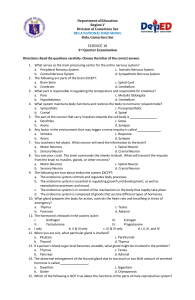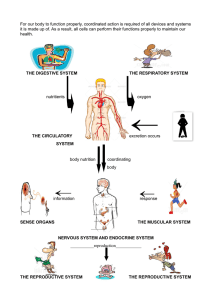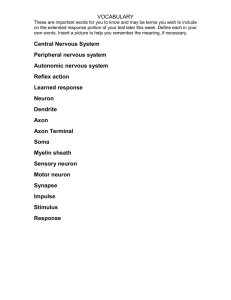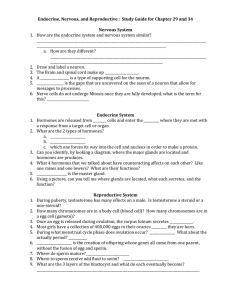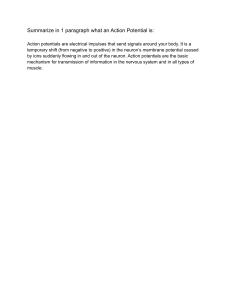Science 10 Exam: Nervous, Endocrine, Reproductive Systems
advertisement
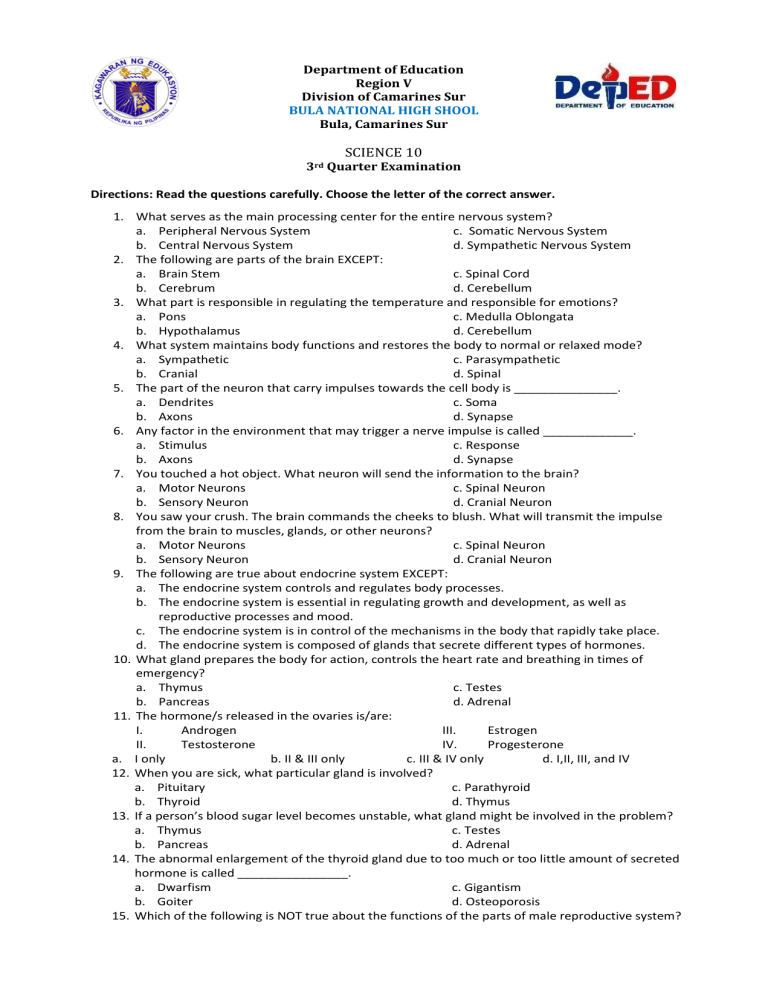
Department of Education Region V Division of Camarines Sur BULA NATIONAL HIGH SHOOL Bula, Camarines Sur 3rd SCIENCE 10 Quarter Examination Directions: Read the questions carefully. Choose the letter of the correct answer. 1. What serves as the main processing center for the entire nervous system? a. Peripheral Nervous System c. Somatic Nervous System b. Central Nervous System d. Sympathetic Nervous System 2. The following are parts of the brain EXCEPT: a. Brain Stem c. Spinal Cord b. Cerebrum d. Cerebellum 3. What part is responsible in regulating the temperature and responsible for emotions? a. Pons c. Medulla Oblongata b. Hypothalamus d. Cerebellum 4. What system maintains body functions and restores the body to normal or relaxed mode? a. Sympathetic c. Parasympathetic b. Cranial d. Spinal 5. The part of the neuron that carry impulses towards the cell body is _______________. a. Dendrites c. Soma b. Axons d. Synapse 6. Any factor in the environment that may trigger a nerve impulse is called _____________. a. Stimulus c. Response b. Axons d. Synapse 7. You touched a hot object. What neuron will send the information to the brain? a. Motor Neurons c. Spinal Neuron b. Sensory Neuron d. Cranial Neuron 8. You saw your crush. The brain commands the cheeks to blush. What will transmit the impulse from the brain to muscles, glands, or other neurons? a. Motor Neurons c. Spinal Neuron b. Sensory Neuron d. Cranial Neuron 9. The following are true about endocrine system EXCEPT: a. The endocrine system controls and regulates body processes. b. The endocrine system is essential in regulating growth and development, as well as reproductive processes and mood. c. The endocrine system is in control of the mechanisms in the body that rapidly take place. d. The endocrine system is composed of glands that secrete different types of hormones. 10. What gland prepares the body for action, controls the heart rate and breathing in times of emergency? a. Thymus c. Testes b. Pancreas d. Adrenal 11. The hormone/s released in the ovaries is/are: I. Androgen III. Estrogen II. Testosterone IV. Progesterone a. I only b. II & III only c. III & IV only d. I,II, III, and IV 12. When you are sick, what particular gland is involved? a. Pituitary c. Parathyroid b. Thyroid d. Thymus 13. If a person’s blood sugar level becomes unstable, what gland might be involved in the problem? a. Thymus c. Testes b. Pancreas d. Adrenal 14. The abnormal enlargement of the thyroid gland due to too much or too little amount of secreted hormone is called ________________. a. Dwarfism c. Gigantism b. Goiter d. Osteoporosis 15. Which of the following is NOT true about the functions of the parts of male reproductive system? 16. a. 17. 18. 19. 20. a. Testis produces sperm cells. b. Scrotum is a sac of skin that holds the testis. c. Penis deposits sperms into the vagina during mating. d. Vas deferens carries sperm and urine out of the body. What are the functions of the female reproductive system? I. Produces female sex cells. II. Receives sperm cells from the male. III. Nurtures the development of and provides nourishment for the new individual I & II only b. II & III only c. I & III only d. I, II, and III What part of the female reproductive system does the fertilized egg develop? a. Ovary c. Fallopian Tube b. Uterus d. Vagina The following statement are true EXCEPT: a. Hormones play an important role in both male and female reproductive systems. b. The parathyroid gland controls the functions of both the testes and the ovaries. c. Hormones control many of the changes in the reproductive system. d. The production of sperm cells and the release of semen can be regulated by hormones. The process through which the level of one substance influences the level of another substance is called ____________. a. Menstrual cycle c. Feedback Mechanism b. Homeostasis d. Hormone Inhibitor What is the term for a heritable change in genetic information? a. Mutation b. Mitosis c. Meiosis d. Apoptosis 21. All of the following are true of RNA except: a. b. c. d. RNA can leave the nucleus RNA contains uracil in place of thiamine RNA is a single strand RNA and DNA have the same 5-C sugar 22. The three nitrogenous bases carried by tRNA is called a. Codon b. Anticodon c. Code d. Genes 23. When a particular individual has three chromosomes of a particular type, this chromosomal aberration is called a. Monosony b. Duplication c. Trisomy d. Inversion 24. Where can most of the fossils be found? a. Sedimentary rock c. Lava flows b. Granite rock d. Black soil 25. Which of the following statements DOES NOT describe evolution? a. Evolution is continuous. c. The world is stable and unchanging. b. Evolution refers to change. d. If there is mutation, there is evolution. 26. Which pair of animals show a correct example of homologous structures? a. Wings of butterfly and bat. c. Fingers of human and arm of starfish b. Flipper of whale and forelimb of cat. d. Tongue of frog and proboscis of mosquito. 27. In what era can the oldest fossil be found? a. Cenozoic b. Mesozoic c. Paleozoic d. Pre-Cambrian 28. Which of the following statements best explains the Theory of Natural Selection? a. Organs that are not used may disappear while organs that are constantly used may develop. b. In nature, the organisms with desirable characteristics may survive while those with weaker traits may not. c. Organisms develop desirable structures to survive in a given environment. d. Acquired characteristics of parents can be passed on to offsprings. 8. Which of the following statement explains Lamarck’s Theory of Use and Disuse? a. Body structures develop because they are used extensively. b. Body structures develop because they are not in use c. Body structures develop because of competition d. Body structures develop because of mutation 9. Which of the following statements supports the idea that extinction is necessary? a. To give way for other organisms to develop b. To let other organisms evolve and progress c. To know who is the fittest d. All of the above 24. 25. Fgfgj 26. Fgjgj 27. Dfhfgh 28. Dghdfgh 29. Prepared by: EVELYN A. BELLEN Teacher 1 JANICE T. OLLERES Teacher 1
